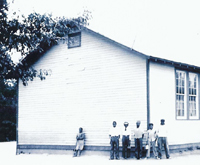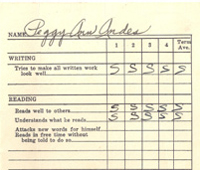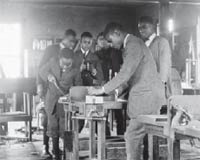Everyday: School Days
 Scrabble School &
students circa 1941. Courtesy of the Rappahannock County Historical Society.
Scrabble School &
students circa 1941. Courtesy of the Rappahannock County Historical Society. Detail of Report Card, Peggy Ann Andes, June 4, 1959. Courtesy of Lillian Aylor
Detail of Report Card, Peggy Ann Andes, June 4, 1959. Courtesy of Lillian Aylor African-American
students learn
cooking, canning &
carpentry skills. Courtesy of the Jackson Davis Collection, University of Virginia
African-American
students learn
cooking, canning &
carpentry skills. Courtesy of the Jackson Davis Collection, University of VirginiaScrabble students followed a well-established routine during their school day. First came reciting the Pledge of Allegiance, followed by devotionals and prayers. The school’s divider was then closed, and two classes set to work—first through third grades on one side, fourth through seventh on the other. Each concentrated on a curriculum the State Board of Education had established, one that stressed the "3 R's": reading, 'riting, 'rithmetic, using flashcards, reading "spellers," and penmanship exercises.
Scrabble School students also received vocational training. For several decades a visiting teacher taught boys industrial arts, such as how to cane chairs and carpentry. Girls learned canning, sewing, and gardening in home economics class.
Much of what the students experienced was typical for children everywhere at the time—white or African American, Rosenwald School or not. But unlike the county's white schools, there was no one at Scrabble to clean the school at the end of the day or prepare hot meals for lunch. And the building lacked indoor toilets and central heating for most of its history. Both girls and boys took turns lighting and maintaining the potbelly stove. Every child had a job to do and expectations were clear. When a student misbehaved, a gravel road circling the school known as "the track" gave them a chance to reflect as they ran laps!
Around the Schoolroom
Scrabble School’s architecture—and its multifunctional design—was on the cutting edge when it was built in 1921.
Audio Recordings
-
Also replaced.
-
Also replaced.
-
Also replaced.
-
Also replaced.